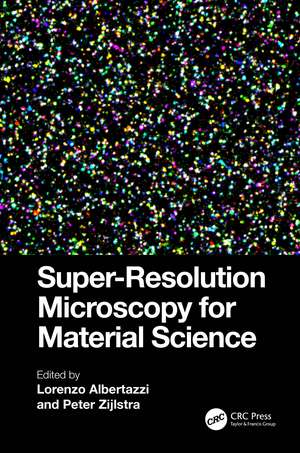Super-Resolution Microscopy for Material Science
Editat de Lorenzo Albertazzi, Peter Zijlstraen Limba Engleză Hardback – 26 mar 2024
This book describes the theory, principles, and practice of super-resolution microscopy in the field of materials science and nanotechnology. There is a growing interest in the applications of SRM beyond biology as new synthetic materials, such as nanoscale sensors and catalysts, nanostructured materials, functional polymers, and nanoparticles, have nanoscopic features that are challenging to visualize with traditional imaging methods.
SRM has the potential to be used to image and understand these cutting-edge man-made objects and guide the design of materials for novel applications.
This book is an ideal guide for researchers in the fields of microscopy and materials science and chemistry as well as graduate students studying physics, materials science, biomedical engineering, and chemistry.
Key Features:
- Contains practical guidance on Super-Resolution Microscopy (SRM), an exciting and growing tool that was awarded the Nobel Prize for chemistry in 2014
- Provides a new perspective targeting materials science, unlike existing books which target readers in chemistry, life science, and biology
- Targets students in its core chapters, while offering more advanced material for professionals and researchers in later chapters
Preț: 788.11 lei
Preț vechi: 961.11 lei
-18% Nou
Puncte Express: 1182
Preț estimativ în valută:
150.89€ • 154.79$ • 127.04£
150.89€ • 154.79$ • 127.04£
Carte tipărită la comandă
Livrare economică 26 februarie-12 martie
Preluare comenzi: 021 569.72.76
Specificații
ISBN-13: 9781032103679
ISBN-10: 1032103671
Pagini: 248
Ilustrații: 1 Tables, black and white; 19 Line drawings, color; 65 Halftones, color; 3 Halftones, black and white; 84 Illustrations, color; 3 Illustrations, black and white
Dimensiuni: 156 x 234 mm
Greutate: 0.62 kg
Ediția:1
Editura: CRC Press
Colecția CRC Press
ISBN-10: 1032103671
Pagini: 248
Ilustrații: 1 Tables, black and white; 19 Line drawings, color; 65 Halftones, color; 3 Halftones, black and white; 84 Illustrations, color; 3 Illustrations, black and white
Dimensiuni: 156 x 234 mm
Greutate: 0.62 kg
Ediția:1
Editura: CRC Press
Colecția CRC Press
Public țintă
Postgraduate and ProfessionalCuprins
Chapter 1: Introduction to super-resolution microscopy and its importance for materials science. Chapter 2: Localization Microscopy. Chapter 3: Stimulated emission depletion microscopy. Chapter 4: Structured illumination microscopy (SIM). Chapter 5: Other super-resolution approaches. Chapter 6: Quantitative Analysis for Single-Molecule Localization Microscopy: “From PSF to Information”. Chapter 7: Single Molecule Localization and Nanoscopy through Sequential Structured Illumination. Chapter 8: Measuring molecule numbers in nano-scale assemblies with single-molecule localization microscopy. Chapter 9: Super-resolution microscopy in colloid science. Chapter 10: SRM application to supramolecular structures. Chapter 11: Super-resolution microscopy application to nanomedicine. Chapter 12: Super-resolution microscopy applications to catalysis. Index.
Notă biografică
Lorenzo Albertazzi is Associate Professor at Eindhoven University, The Netherlands, within the department of Biomedical Engineering. He obtained a MSc in Chemistry (2007) and a PhD in Biophysics (2011) from Scuola Normale Superiore (Pisa, Italy). He then joined Eindhoven University of Technology as postdoctoral researcher and in 2014 he became a NWO/VENI fellow. In 2015, he moved to Barcelona (Spain) to the Institute of Bioengineering of Catalonia (IBEC) to start the 'Nanoscopy for Nanomedicine' group. Since 2018 he is associate professor at TU/e leading the research group Nanoscopy for Nanomedicine.
Peter Zijlstra is an Associate Professor at Eindhoven University, The Netherlands, in the research group Molecular Biosensing within the department of Applied Physics. He studied Applied Physics at the University of Twente (Enschede, The Netherlands), where he obtained his MSc degree in 2005. In 2009, he received his PhD from Swinburne University of Technology (Melbourne, Australia), where he studied the photothermal properties of single plasmonic nanoparticles with applications in optical data storage. After a postdoctoral fellowship in the lab of Prof. Michel Orrit at Leiden University (The Netherlands) he moved to Eindhoven University of Technology (TU/e, The Netherlands). He is a core member of the Institute for Complex Molecular Systems at TU/e, wherein groups from different disciplines (chemistry, physics, biomedical engineering, mathematics) collaborate on multidisciplinary research topics.
Peter Zijlstra is an Associate Professor at Eindhoven University, The Netherlands, in the research group Molecular Biosensing within the department of Applied Physics. He studied Applied Physics at the University of Twente (Enschede, The Netherlands), where he obtained his MSc degree in 2005. In 2009, he received his PhD from Swinburne University of Technology (Melbourne, Australia), where he studied the photothermal properties of single plasmonic nanoparticles with applications in optical data storage. After a postdoctoral fellowship in the lab of Prof. Michel Orrit at Leiden University (The Netherlands) he moved to Eindhoven University of Technology (TU/e, The Netherlands). He is a core member of the Institute for Complex Molecular Systems at TU/e, wherein groups from different disciplines (chemistry, physics, biomedical engineering, mathematics) collaborate on multidisciplinary research topics.
Descriere
This book is an ideal guide for researchers in the field of microscopy and materials science and chemistry as well as graduate students studying physics, materials science, biomedical engineering, and chemistry.
